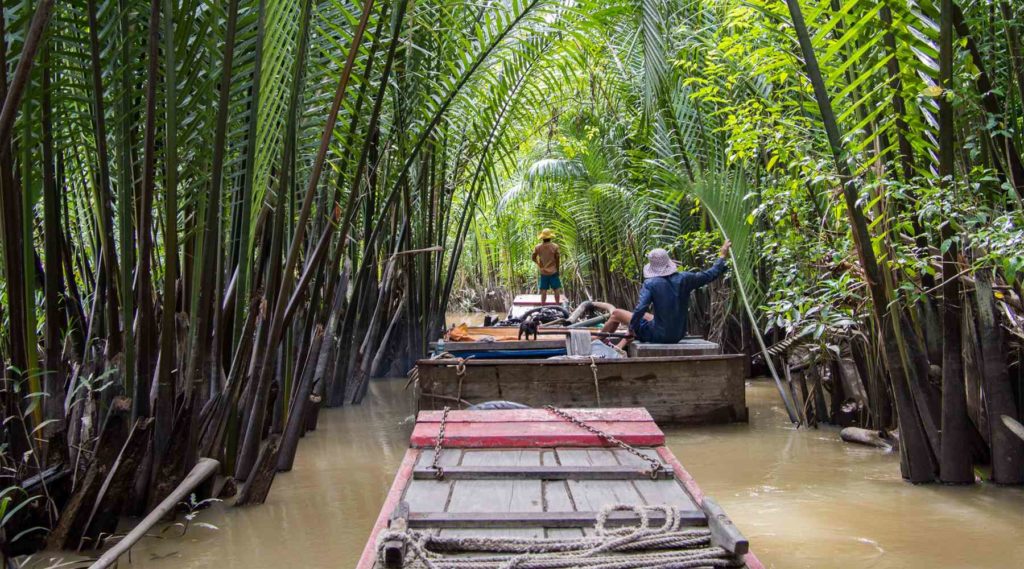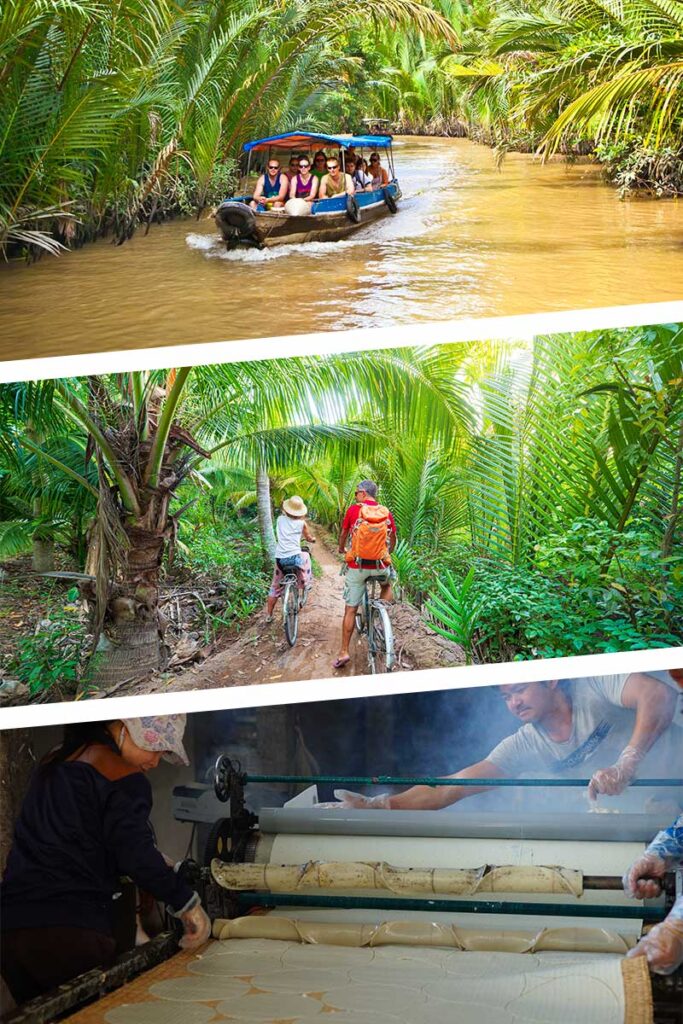Ben Tre – Coconut country of the Mekong Delta
Ben Tre is a province in the eastern Mekong Delta, only a couple of hours from Ho Chi Minh City, where three branches of the Mekong River split into a maze of waterways. The capital city, also called Ben Tre, is a small, low-rise town with little to detain you beyond markets and a riverside promenade. The real charm lies in the surrounding countryside: islands and rural communes where palm trees lean over canals, ferries connect backroads, and bicycles or boats are the natural way to get around.
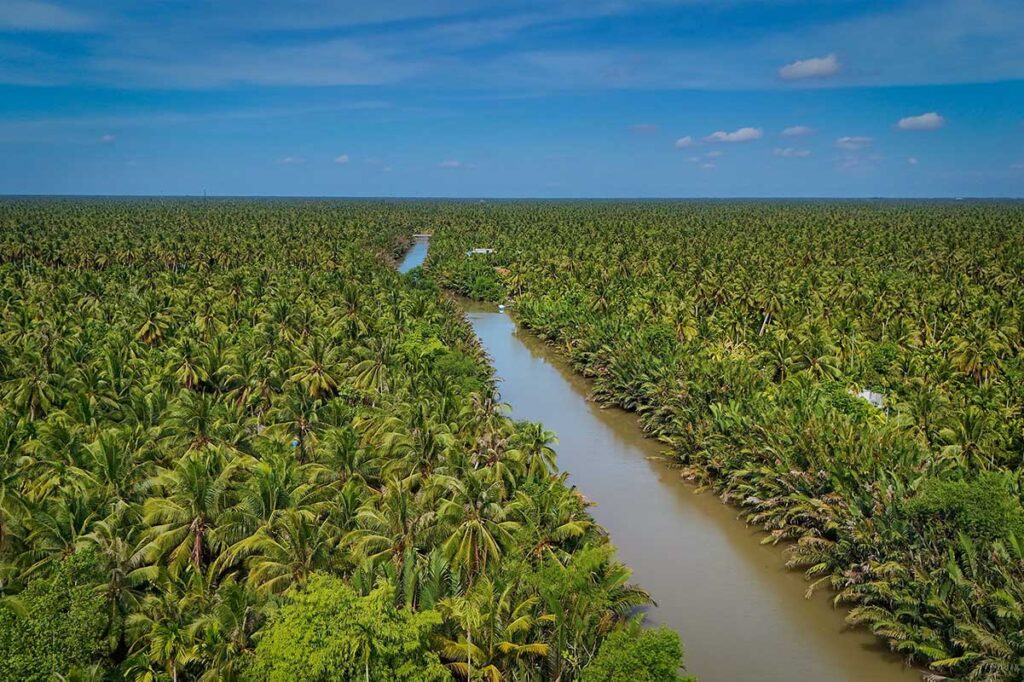
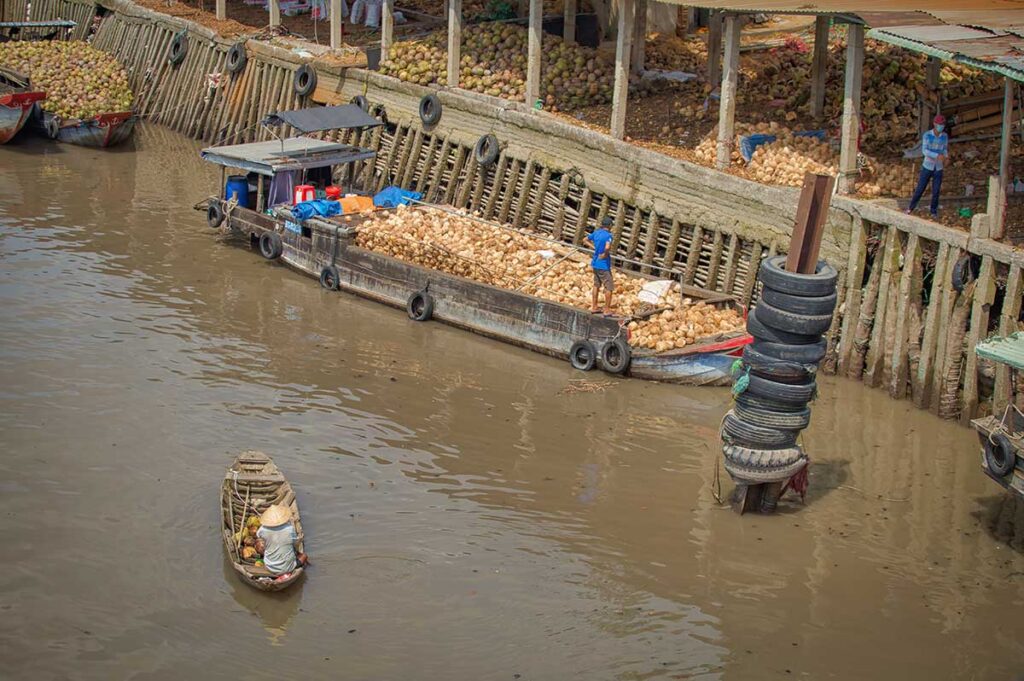
This is not a destination of dramatic landmarks but of slow travel. Life here is tied to coconuts, fruit orchards, and small family workshops, with tourism ranging from simple homestays to classic day-trip circuits that can feel staged. The province is also remembered for its role in the “Dong Khoi” uprisings during the Vietnam War, something you can still see reflected in local museums and monuments. Today Ben Tre is better known as Vietnam’s “coconut kingdom,” with candy, handicrafts, and bonsai gardens from Cho Lach district all part of its quiet, small-town identity.
Best things to do in Ben Tre
Ben Tre isn’t about big-ticket landmarks or bucket-list monuments. The real appeal lies in activities that get you onto the canals, into orchards, and through small villages. The best things to do in Ben Tre are slow, simple experiences: boat rides, cycling routes, visits to local workshops, and time spent in a homestay. Some day tours from Ho Chi Minh City follow heavily scripted circuits with staged music or pushy shopping stops, but if you choose carefully, you can still find routes that feel calm and authentic.
1. Boat trip & sampan rides through the canals
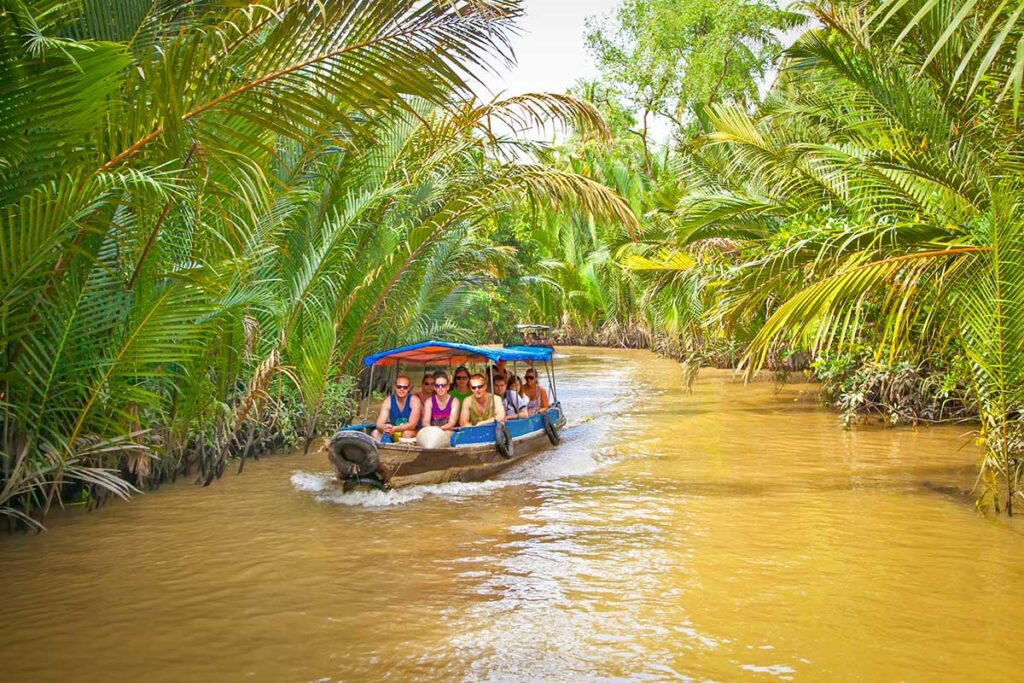
A boat trip is the most classic thing to do in Ben Tre. Larger motorboats take you along the main channels, while hand-rowed sampans slip into shaded arroyos where palms arch overhead. Tours usually last two to four hours, and can be booked privately or as part of a shared group. A good route limits the number of souvenir or candy stops and focuses more on quiet waterways.
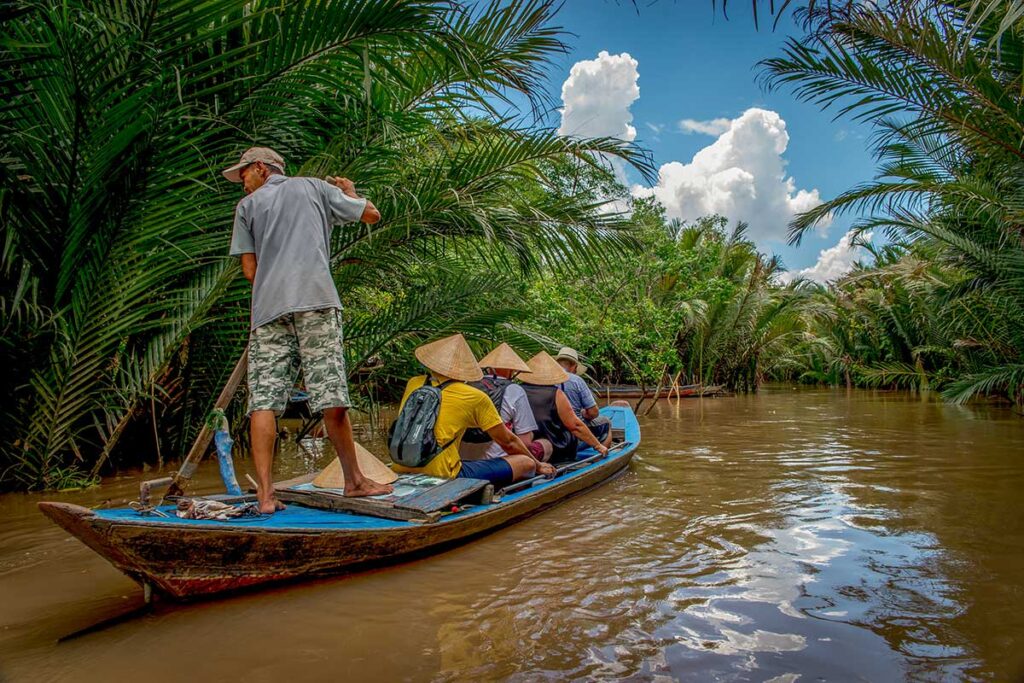
Early mornings and late afternoons are the most scenic times, when the light is softer and boat traffic is lower. Life jackets should be provided, though not every operator enforces them, so it’s worth checking before departure. The experience can be very atmospheric, but how enjoyable it is depends heavily on the operator and the route they take.
2. Cycling through the countryside
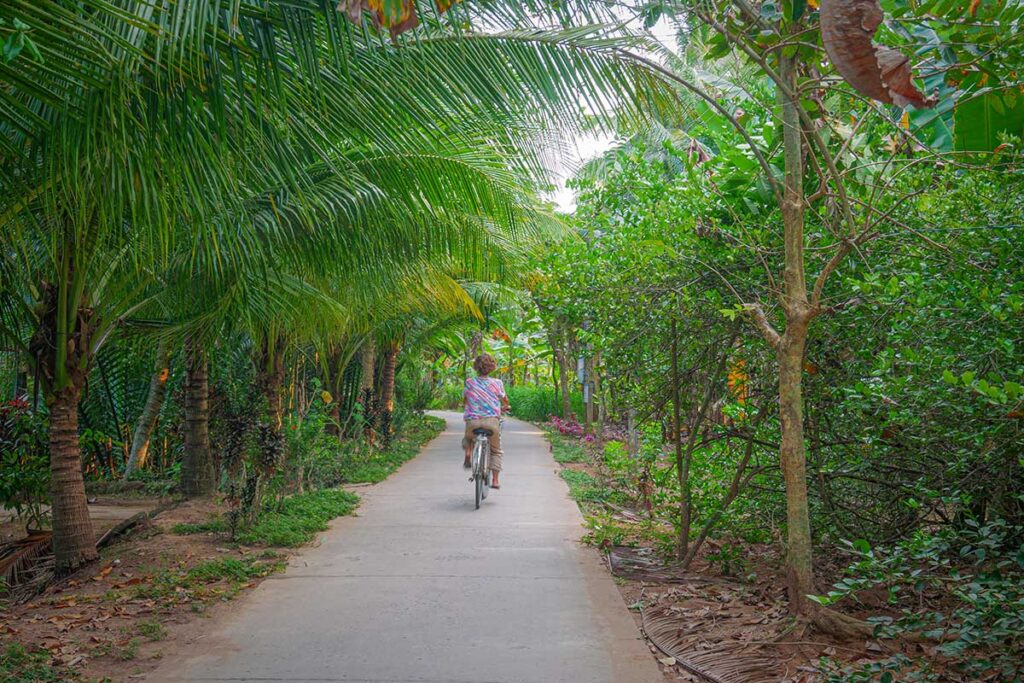
Flat lanes, palm-shaded paths, and small ferries make Ben Tre one of the easier places in the Delta for cycling. Short loops from homestays are ideal if you just want to pedal through orchards, cross small bridges, and stop for coffee along the way. Going deeper into the region requires better planning: free bicycles from accommodations are fine for nearby rides, but longer trips need sturdier bikes and some navigation confidence.
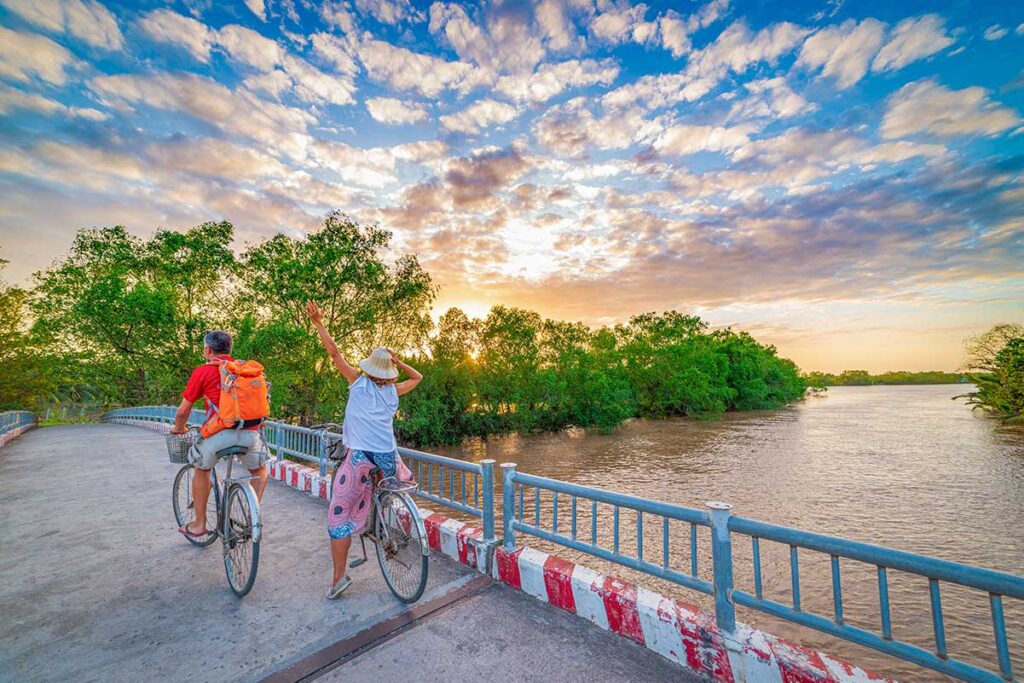
Ferries are frequent and straightforward — just watch how locals ride on and follow their lead. In the dry season, heat can be intense in the middle of the day, while the rainy months may bring muddy paths and slippery bridges. With the right timing, cycling here is one of the best things to do in Ben Tre to see daily life at a gentle pace.
3. Explore local villages & workshops
Around Ben Tre, you’ll come across traditional workshops where locals still practice age-old crafts using coconuts, bamboo, sedge, and rice. These visits give you a glimpse of rural life and handmade production in the Mekong Delta. Some workshops are small and casual, while others allow you to see the full process. Always ask before taking photos, and don’t feel pressured to buy unless you really want to.
Bamboo weaving – baskets, trays, and other household items (example: Phuoc Tuy).
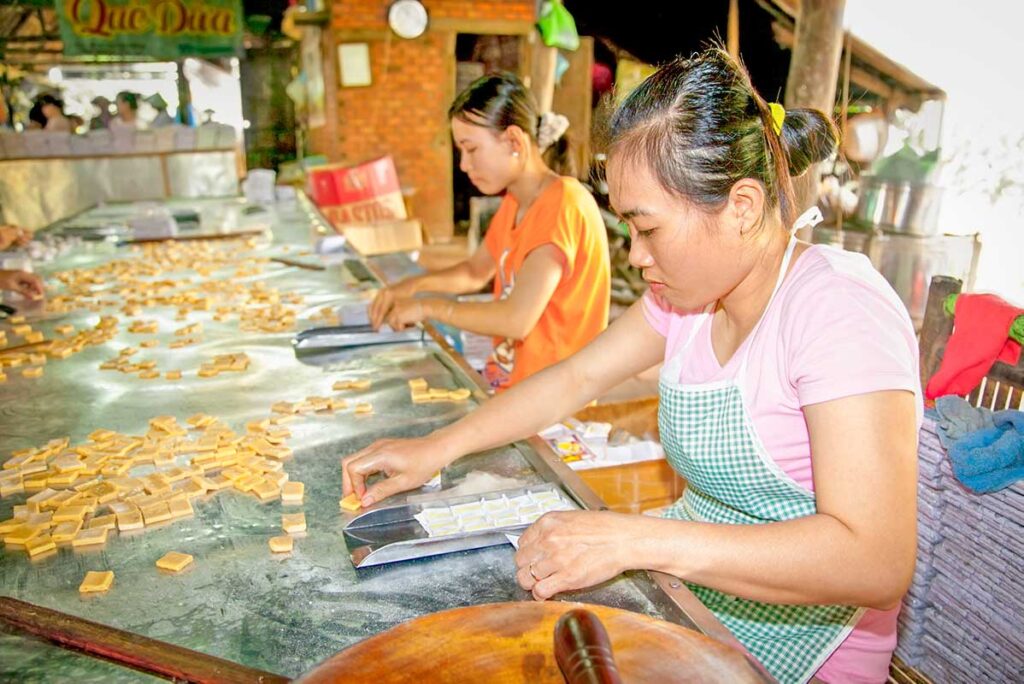
Coconut products – from kitchen utensils and décor items to basket weaving (examples: Phuoc Long, Hung Phong).
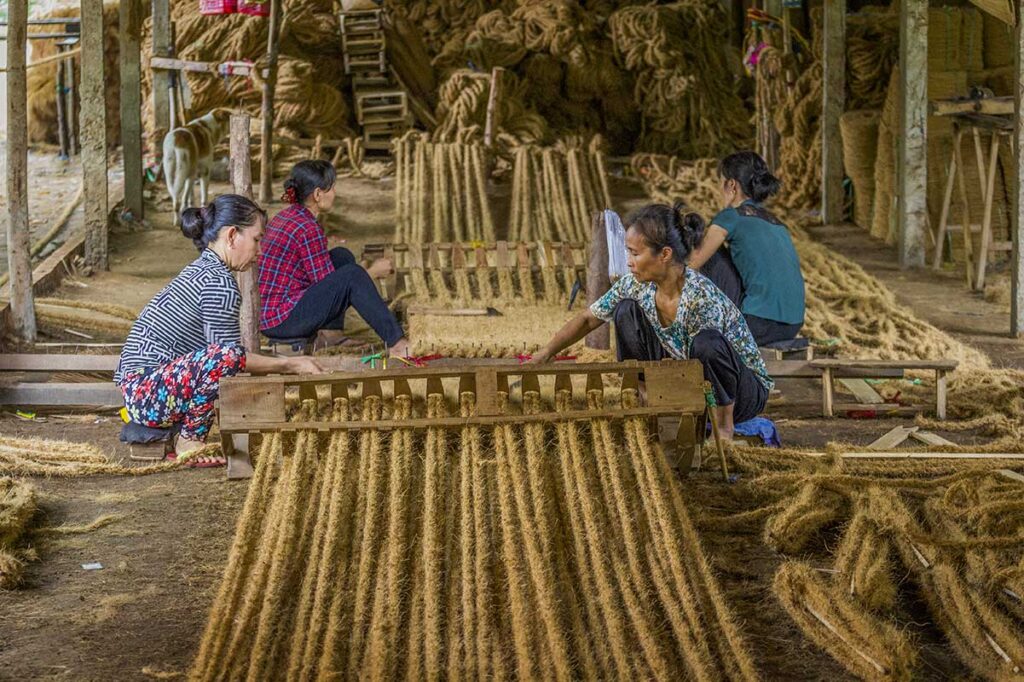
Sedge mat weaving – colorful sleeping mats made on handlooms (example: An Hiep).
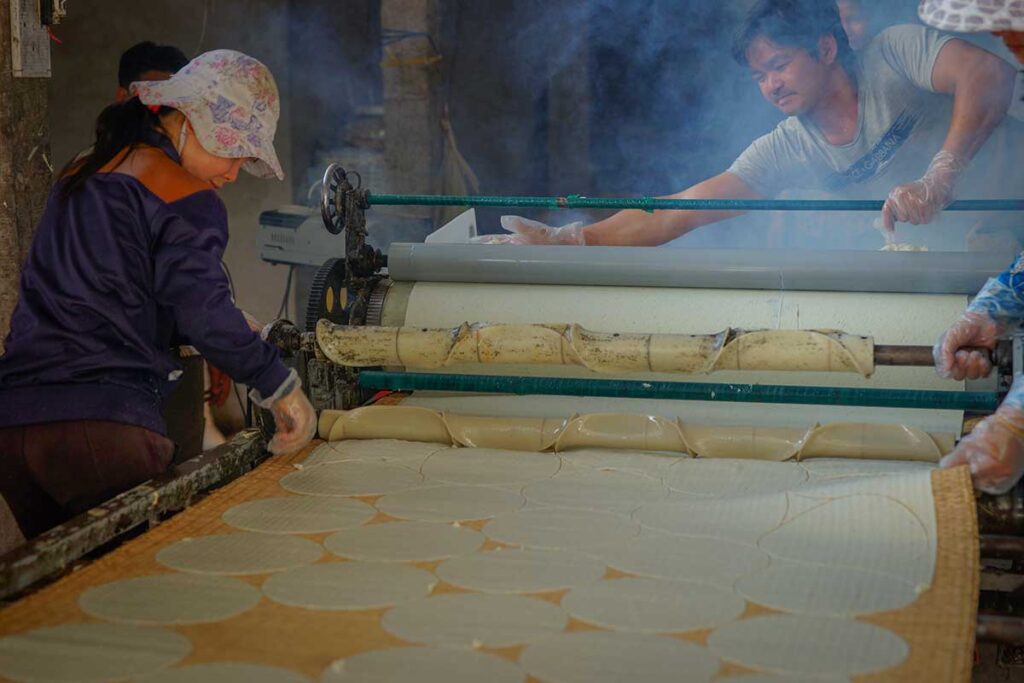
Rice paper making – round sheets dried in the sun or puffed into crunchy snacks (examples: My Long, Son Doc).
4. Kayaking & SUP on quiet canals
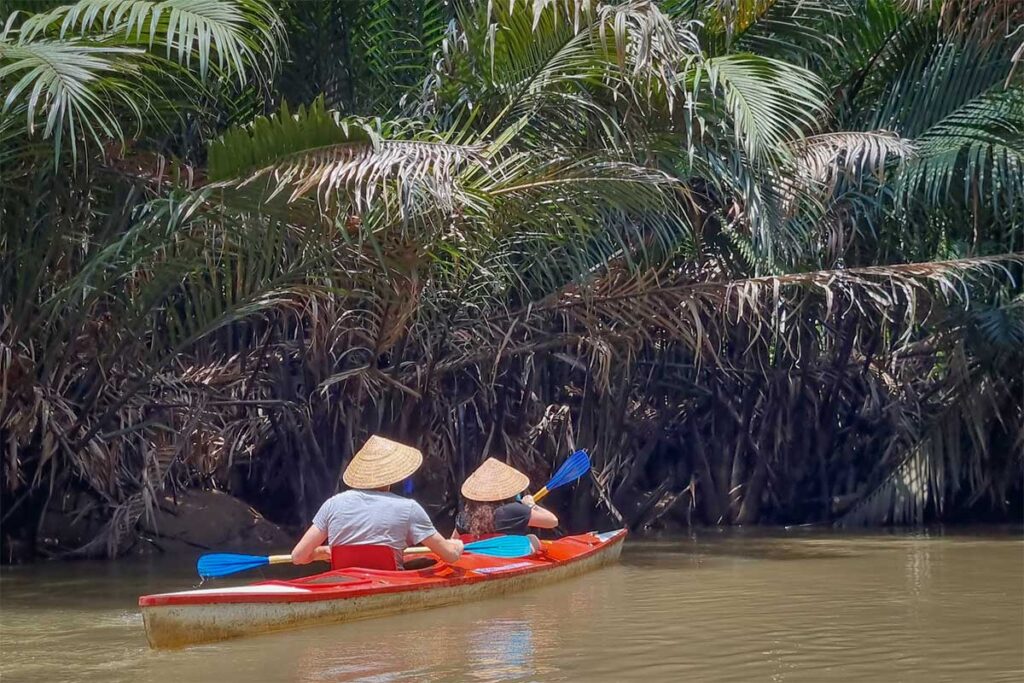
In some eco-tourism areas and homestays with access to calmer waterways, you can rent a kayak or try stand-up paddleboarding. It’s a peaceful way to explore, especially in the late afternoon, when the light is golden and traffic on the canals slows. Safety gear isn’t always provided, so check for life jackets before you go. Be mindful of tides and currents, and wear quick-drying clothes or sandals you don’t mind getting wet. This isn’t a mainstream activity yet, but for those who enjoy being on the water, it’s a rewarding addition to a Ben Tre stay.
5. Fruit picking at orchards
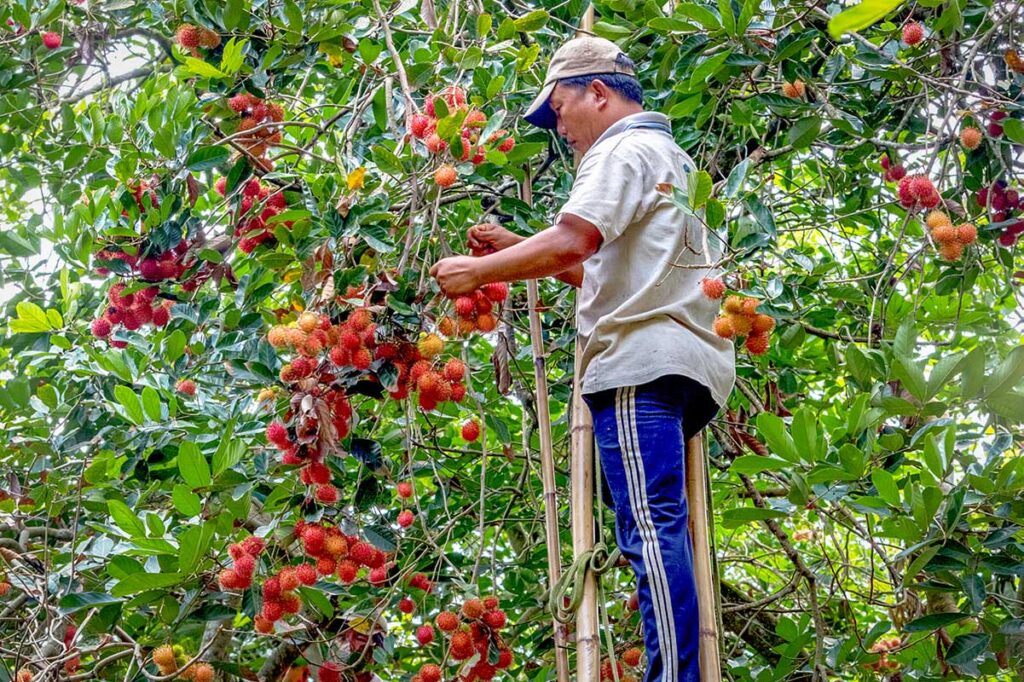
One of the most enjoyable things to do in Ben Tre is visiting an orchard and tasting fruit straight from the garden. Orchards are usually family-run and visitors are welcome to walk through, sample fruit in season, and sometimes pick their own. A small tasting fee is common, and it’s polite to accept what is offered rather than picking freely. The most famous hub is Cai Mon Orchard Village, where durians, pomelos, and mangosteens thrive, but you’ll find plenty of smaller gardens across the province. Fruit season peaks between June and August, though there is always something growing year-round.
6. Bird spotting at Vam Ho Bird Sanctuary
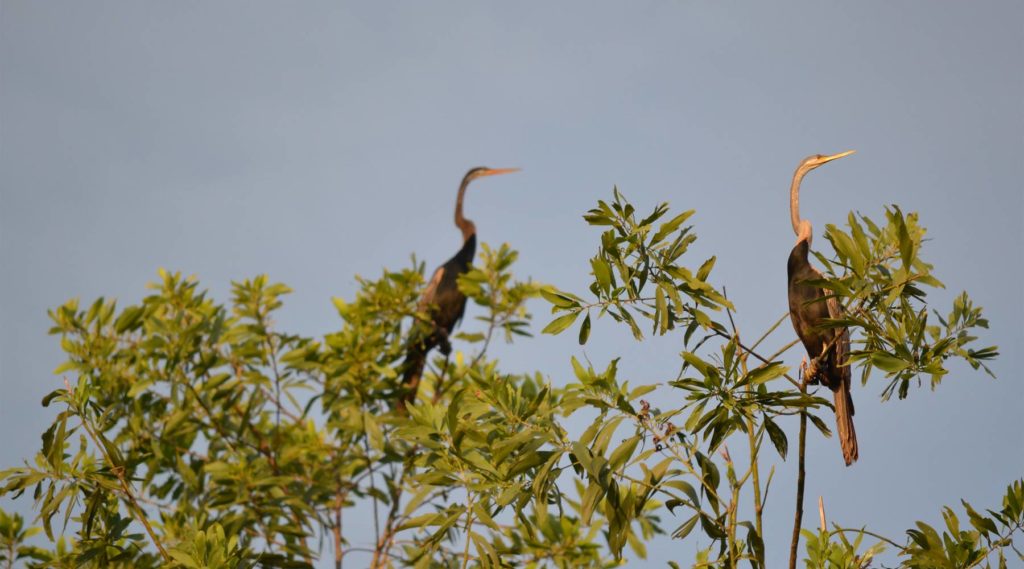
For nature lovers, Vam Ho Bird Sanctuary is one of the best things to do in Ben Tre. This mangrove reserve shelters more than 80 species of birds, with the highlight being the storks and egrets that gather in the thousands during breeding season. The most dramatic time to visit is late afternoon, when flocks return to roost in the trees. You can explore by boat or on simple trails with bamboo bridges, but be prepared for mud and bring insect repellent. It’s not a major tourist site, so facilities are basic, but the sheer number of birds makes the trip worthwhile.
7. Ben Tre Revolutionary Museum (War gallery)
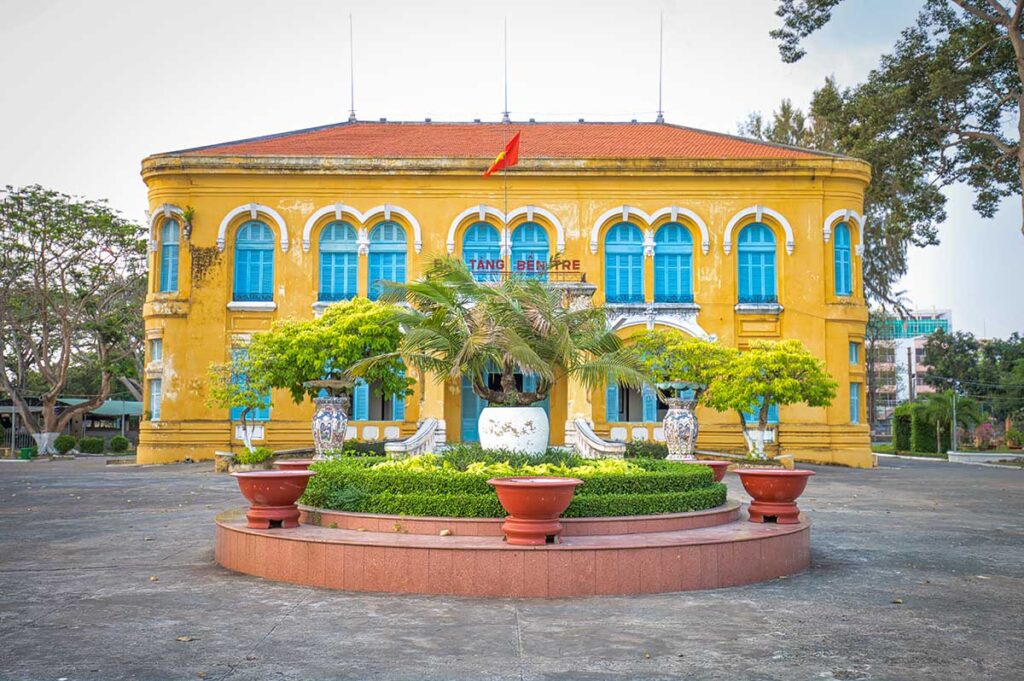
If you’re curious about the province’s war history, the Revolutionary Museum provides context for Ben Tre’s role in the “Dong Khoi” uprisings during the Vietnam War.
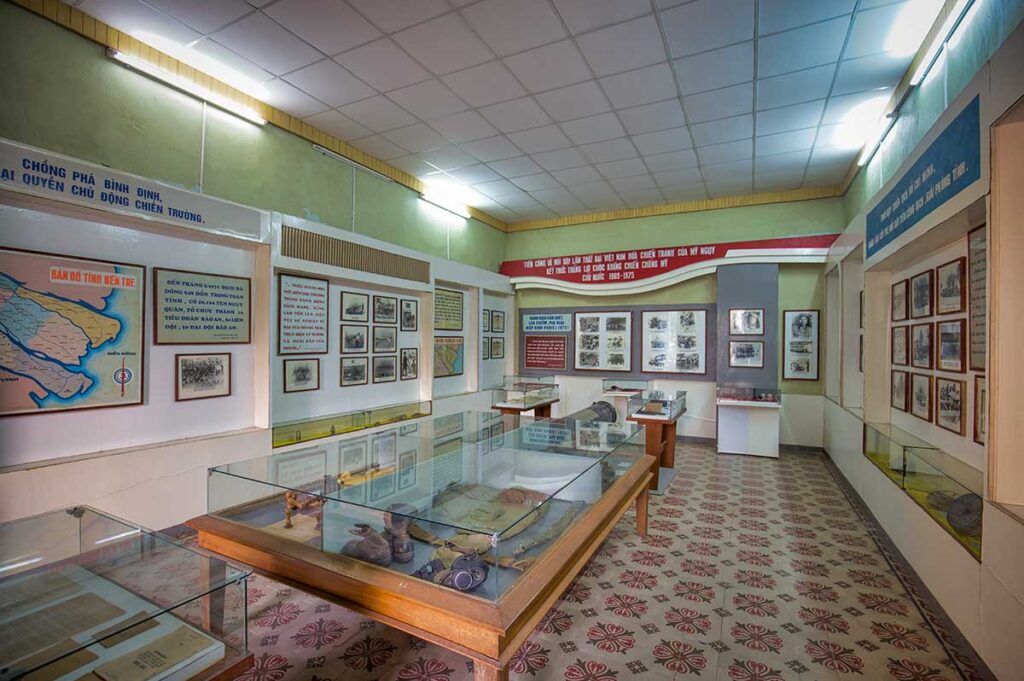
The small galleries display photos, weapons, and memorabilia, though English explanations are limited. It’s best visited as part of a short walk through the city center, combining it with the riverside promenade or Ben Tre Market. The museum won’t take more than 30–45 minutes, but it offers a local perspective on events that shaped the area.
8. Van Phuoc Pagoda
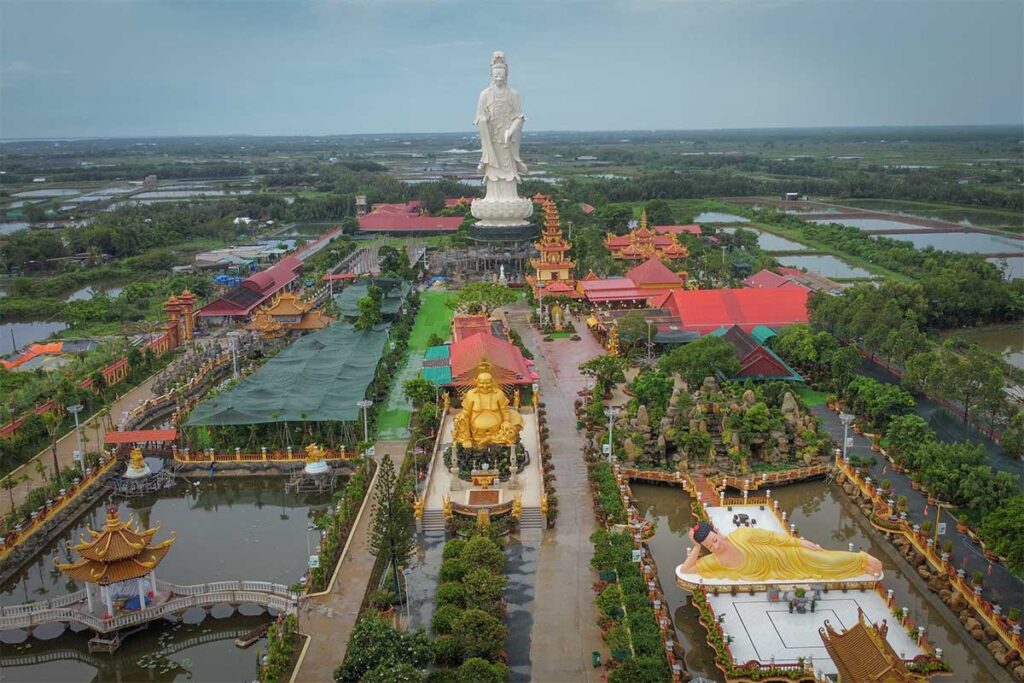
Van Phuoc Pagoda is one of the older Buddhist temples in the province, dating back to the 19th century. Architecturally, it reflects traditional southern Vietnamese pagoda design with curved roofs, colorful carvings, and a calm garden setting. It’s a place for quiet reflection rather than a standout attraction, so treat it as a short cultural stop. Dress modestly and keep your visit respectful, especially if ceremonies are underway.
9. Discover the islands (con/islets)
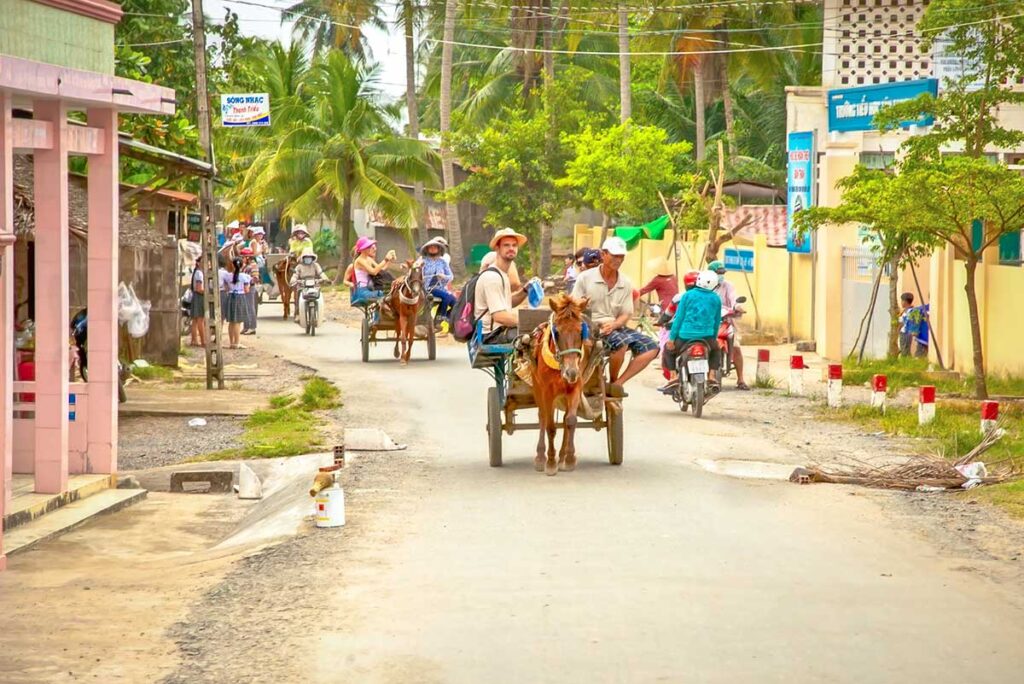
The Mekong Delta word “cồn” refers to river islets, and exploring them is another classic thing to do in Ben Tre. Each island has a rural pace of life with ferries, orchards, and craft workshops. Con Quy (Turtle Islet) and Phung (Phoenix) Islet are the most visited, while Thoi Son is often included in day trips from Ho Chi Minh City and can feel more staged.
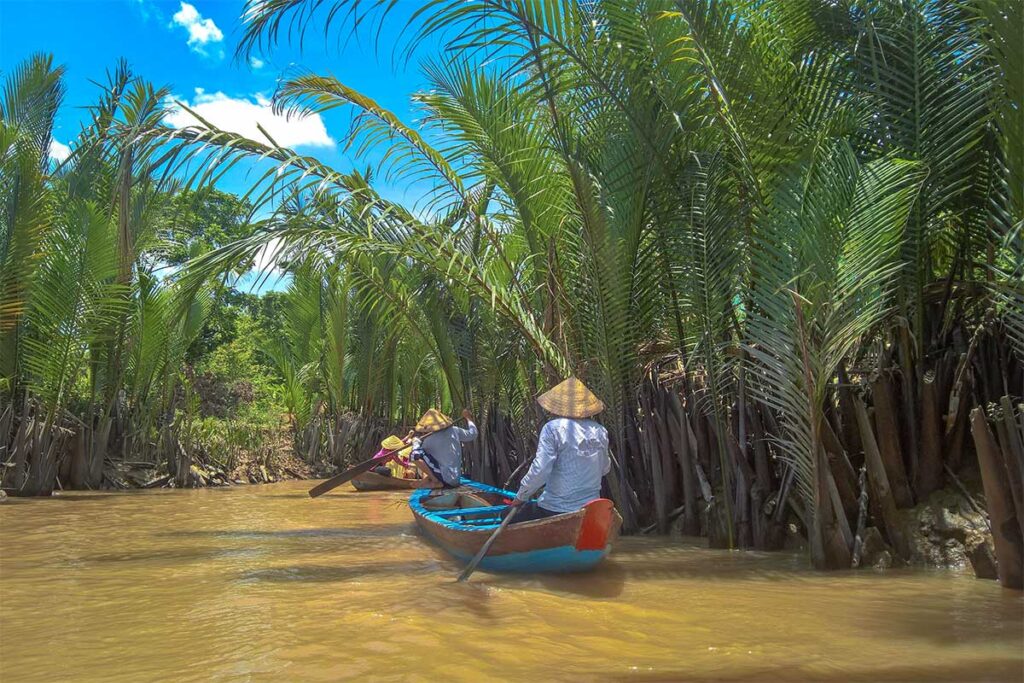
Smaller islets and areas like An Hiep remain less commercial. Be aware that popularity often means more touristy activities like horse carts and packaged fruit tastings. If you prefer authenticity, ask your operator to focus on smaller waterways and villages instead of the busiest islets.
10. Tuyen Linh Temple
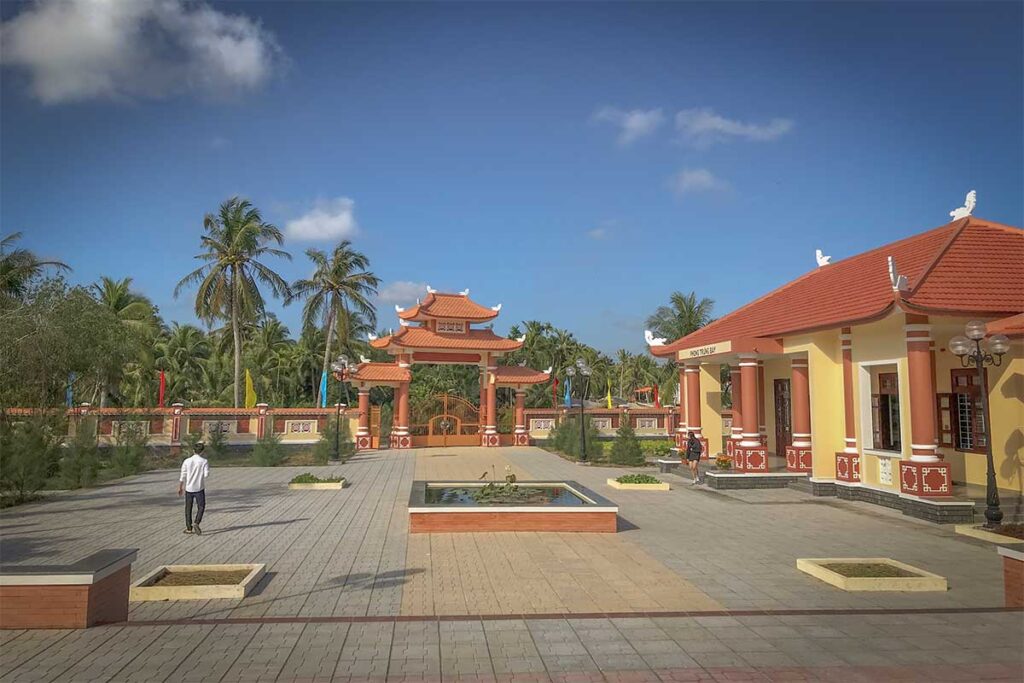
This modest temple is historically important because it was visited by Nguyen Sinh Sac, father of Ho Chi Minh, and later connected with early communist movements. The current structure has been rebuilt several times after war damage, so there’s not much original architecture left. Still, it makes an interesting short stop if you’re already nearby, more for its history than its visual appeal.
11. Local markets for daily life
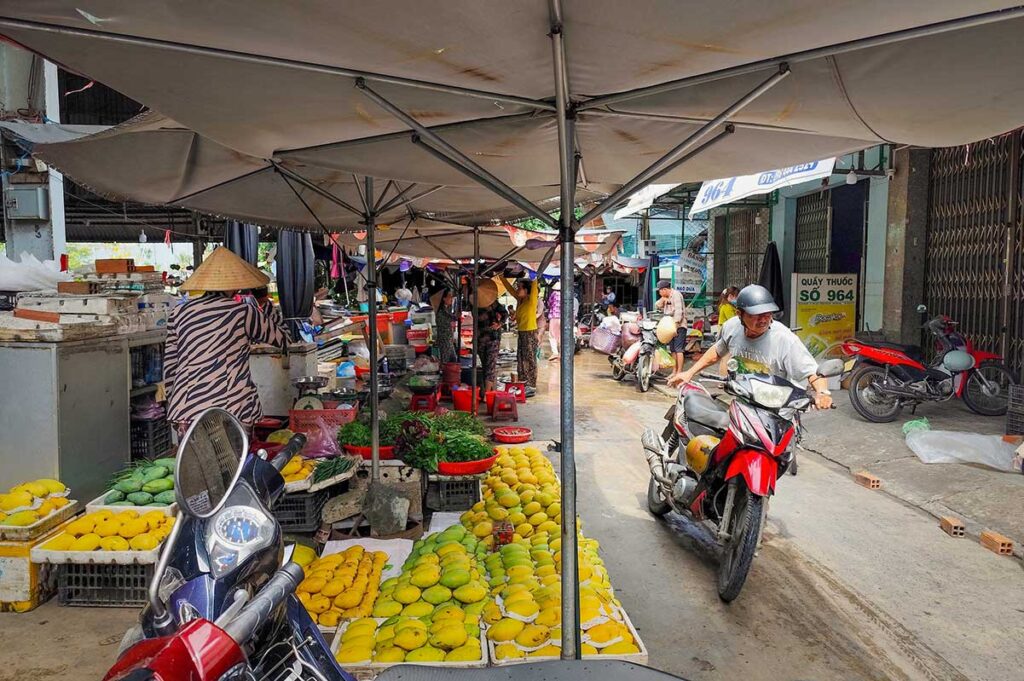
Markets are one of the best things to do in Ben Tre if you want to experience everyday life. Ben Tre Market is busiest in the morning, selling fresh produce, meat, fish, and flowers.
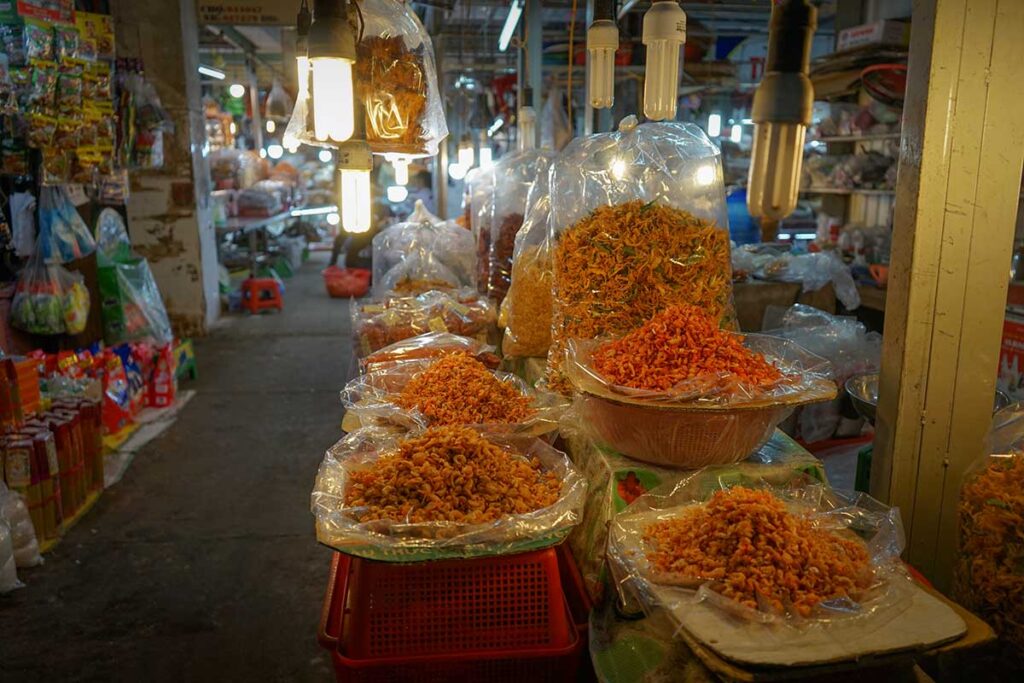
In the evening, the Ben Tre Night Market adds clothes, souvenirs, and plenty of coconut-based crafts. Outside the city, you’ll find countless small village markets where daily rhythms unfold without tourists. Bring cash, expect some chaos, and watch your belongings in crowded areas.
12. Stay overnight in a homestay

Many travelers only see Ben Tre on a rushed day trip, but staying overnight changes the experience completely. Homestays put you right by the river or in a village, with bicycles to explore and boats at the doorstep. Meals are usually shared with the family, which gives you a chance to try simple home cooking and learn more about life here. Expect rustic comforts: fans instead of strong air-conditioning, mosquito nets, and sometimes patchy Wi-Fi. It may not be luxury, but for many visitors, this is the most memorable thing to do in Ben Tre.
Best time to visit Ben Tre
Does timing matter?
The timing of your trip does make a difference in Ben Tre. Rain levels affect cycling and boat trips, river levels change the look of the canals, and fruit seasons can make the orchards more rewarding. That said, the province is possible to visit year-round if you plan around the weather.
Dry season (Dec–Apr)
This is the most predictable period for travel, with less rain and easier logistics for cycling or boat tours. Days are hot and sunny, but the rivers can be lower and the landscape less lush compared to wetter months.
Rainy season (May–Nov)
Expect short but heavy showers, often in the afternoon. The upside is greener scenery and fresher air, but some paths may flood briefly. Planning boat rides or longer bike trips for mornings usually avoids disruption.
Fruit & flower seasons
If you want to see orchards at their best, June to August is peak fruit season, with durian, rambutan, and mangosteen all available. In Cho Lach and Cai Mon, ornamental flower gardens come alive around Tet (January–February), when plants are prepared for the Lunar New Year market.
How to get there?
Where is Ben Tre?
Ben Tre is a Mekong Delta province southwest of Ho Chi Minh City, with its main town sitting on the Ham Luong River. Thanks to new bridges, you no longer need a ferry to get here from Saigon, making the journey quicker and easier than in the past.
From Ho Chi Minh City (Saigon)
The most common option is by bus. Several companies run frequent departures throughout the day, with the ride taking around two hours depending on traffic. Buses drop you at Ben Tre Bus Station, from where you’ll need a taxi or motorbike transfer to reach rural homestays.
A private car with driver is more expensive but saves time, allows you to stop along the way, and drops you exactly at your accommodation — useful if you’re short on time or traveling as a family.
Riding a motorbike from Saigon is possible but only for experienced drivers. The highways can be chaotic, and local traffic rules are loosely followed.
Day trips from Saigon
At just about two hours from Ho Chi Minh City, Ben Tre is one of the most popular Mekong Delta day trip destinations. A day is enough time for a boat tour, a cycle through the countryside, and a taste of coconut workshops or orchards. Quality varies between operators: some itineraries lean heavily on staged stops, while others focus more on quieter canals and authentic villages. If you only have limited time, a well-planned day tour is still a great option. With more time, staying overnight gives you access to less-visited areas and the slower rhythms of local life.
Deeper in the Mekong Delta Day Tour (Ben Tre)
- Experience Boat trip, Xe Loi ride, and cycling through Ben Tre’s coconut groves.
- Highlights Coconut workshop, mat weaving, and local fruit tastings.
From other Delta bases
From Can Tho, buses and private cars take about three hours. From Vinh Long, Cai Be, or My Tho, the journey is shorter — typically one to two hours by local bus or car. Arranged boat transfers between provinces do exist and can be scenic, but unless you have a group to share the cost, they are usually far pricier than road transport.
How to get around
Boat tours
Boats are the main way to experience Ben Tre’s canals. You can book a private trip or join a shared tour; private boats cost more but give you control over the pace and route. A quality tour spends more time on quiet waterways and less at staged stops like candy shops or souvenir stalls.
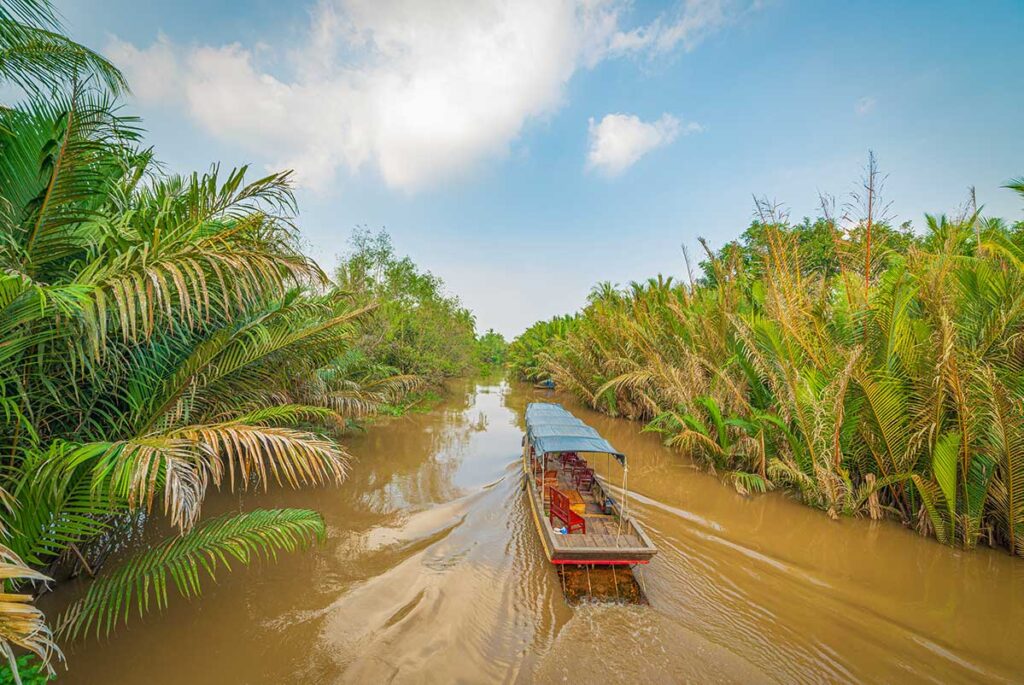
Trips usually last two to four hours, and fair prices are in the mid-range — too cheap often means lots of shopping detours. Lifejackets should be available, but not every operator enforces them, so check before setting off.
Cycling
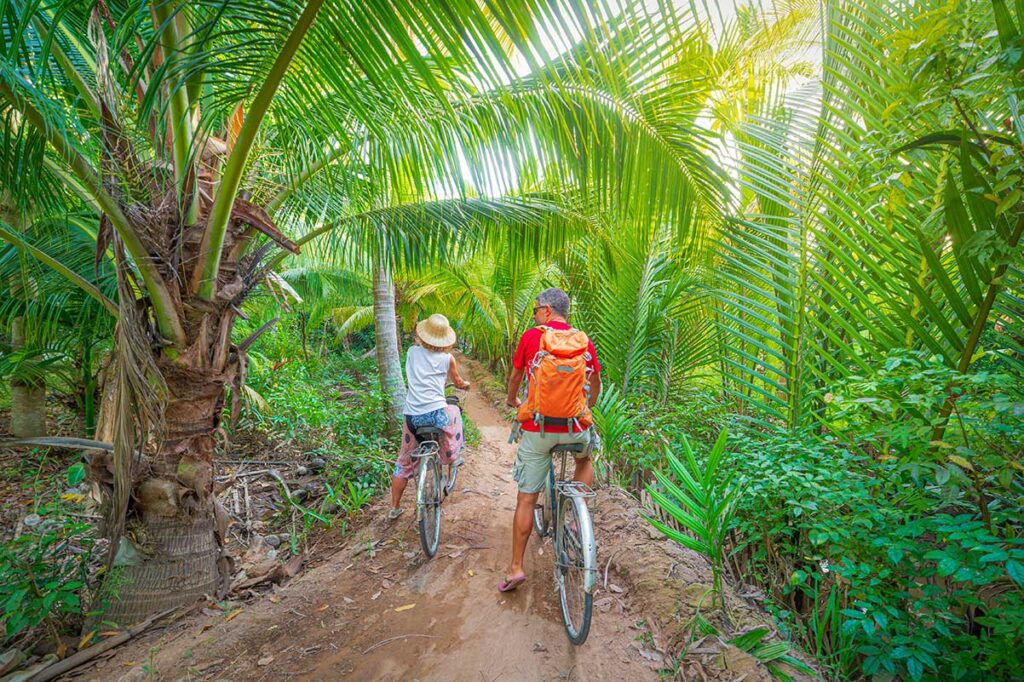
Cycling is one of the best ways to explore the countryside around homestays. Short loops through villages and orchards are easy and pleasant, but longer distances require better bikes than the free ones many homestays provide. Check seats, brakes, and helmets before heading out. Heat can be intense in the dry season, so it’s best to ride early or late in the day. In the rainy season, muddy paths and slippery bridges can make long rides less enjoyable.
Motorbike (scooter)
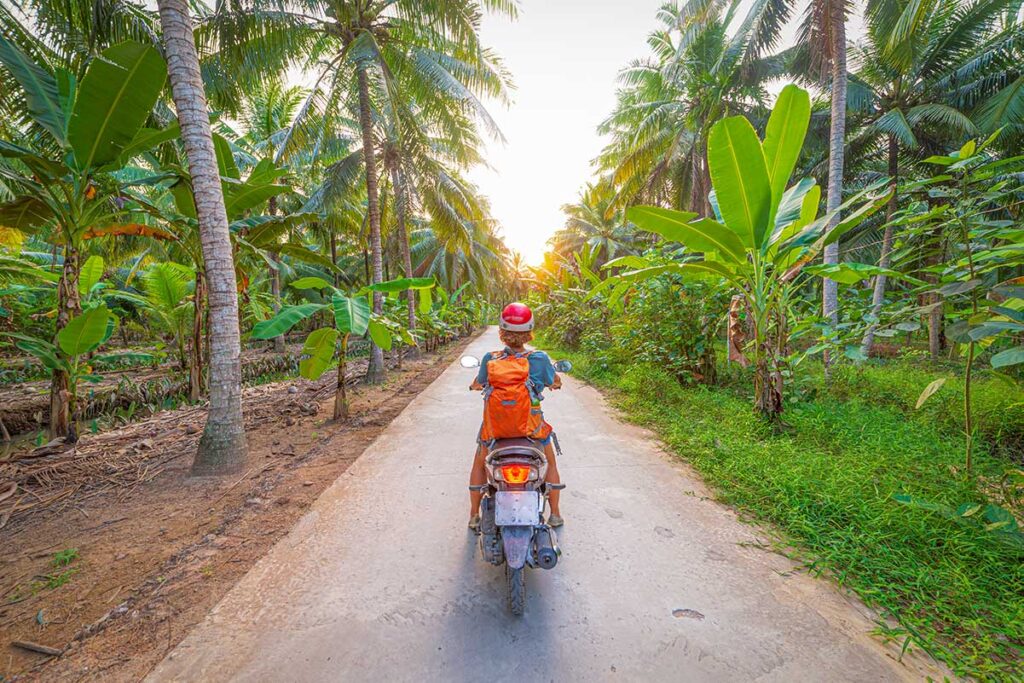
Renting a scooter lets you cover more ground, but it’s not for everyone. Some of the rural lanes are only wide enough for one bike, and dead-ends are common. Locals are used to this and drive slowly, but visitors need to be confident with tight turns and ferry crossings. For less experienced riders, sitting on the back of an “easy rider” motorbike tour can be a safer way to explore.
Car with driver
A car makes sense if you’re traveling with family, elderly relatives, or simply want to avoid the heat and rain. It’s also the best option if you plan to combine scattered sites like Vam Ho Bird Sanctuary, Cai Mon Orchard, and craft villages in one day. While you’ll miss some of the smaller backroads, it’s a comfortable way to get around with minimal hassle.
Staying in Ben Tre
Ben Tre makes a quieter overnight base than nearby My Tho, especially if you want to reach authentic backroads rather than the busier day-trip circuits. Spending the night means you can join early-morning market visits, cycle before the heat, and enjoy the calm of the rivers once most day visitors have gone.
The most rewarding areas to stay are in the rural communes and islets along the rivers, where homestays and small lodges put you right on the water. These spots give you easy access to boats and cycling loops from the doorstep. The city center offers more restaurants and convenience, but it feels less atmospheric and further from the real countryside charm.
Accommodation types range from family-run homestays (the most character and best cultural experience), to simple riverside lodges, and a handful of mid-range resorts aimed at domestic travelers. Expect rustic comforts: mosquito nets, fans or basic air-con, family-style meals, and the sound of roosters at dawn. Meals are usually included, and they tend to be generous spreads of local dishes with plenty of coconut flavor. For popular weekends or Vietnamese holidays, it’s wise to book ahead as many places fill with local visitors.
Travel tips for Ben Tre
Avoiding overly touristy circuits
When arranging a boat trip, ask how much time will be spent on quiet canals versus shop visits. A good operator will focus more on waterways and daily life, not just candy factories or souvenir stops. If you prefer less staging, make it clear you’d rather skip horse carts or long breaks at tourist cafés.
Money & logistics
Bring enough cash for markets, ferries, and small village shops, as card payment is rarely possible outside the city. ATMs are available in Ben Tre town but less common in the countryside. Mobile signal is decent, though offline maps help when small ferry detours confuse GPS.
Heat & rain planning
Start cycling or exploring early in the morning, take a long break during the midday heat, and resume in the late afternoon. In the rainy season, a poncho is more practical than an umbrella, and sturdy sandals or quick-dry shoes are best for muddy or wet paths.
Food notes
Meals in rural Ben Tre are often simple but hearty, with plenty of coconut-based dishes and fresh orchard fruit. Don’t expect a broad dining scene — restaurants are concentrated in town, while homestays serve family-style cooking. Nightlife is minimal, so evenings usually mean relaxing by the river or chatting with your hosts.
2-day travel itinerary
Day 1
- Morning: Private boat tour with a mix of motorboat and sampan; ask for more canal time and fewer shop stops.
- Late morning: Arrive at your homestay, check in, and enjoy a home-cooked lunch.
- Afternoon: Cycle a countryside loop with small ferry hops, orchard lanes, and palm-shaded paths.
- Evening: Head into town for a riverside stroll and browse the night market before returning to your homestay.
Day 2
- Morning: Visit a local orchard for fruit tastings, or make a side trip to Cai Mon’s fruit and flower gardens.
- Afternoon: Option A – Vam Ho Bird Sanctuary, with late-day bird fly-ins. Option B – a craft-village circuit (mat weaving, rice paper, coconut products).
- Late afternoon: Paddle a kayak or SUP near your homestay while the sun sets.
- Evening: Share dinner with your host family, often the highlight of a stay in Ben Tre.
Is Ben Tre worth visiting?
Ben Tre is worth visiting if you’re drawn to quiet canals, cycling through palm groves, and staying in rustic riverside homestays. It’s less compelling for travelers looking for major landmarks, busy nightlife, or a dense list of “must-sees.” The province is more about atmosphere than sights.
As a day trip from Ho Chi Minh City, Ben Tre works well if you only want a short taste of the Mekong Delta. But staying one or two nights makes a big difference: you’ll reach areas beyond the standard tour-bus routes, have time for early-morning or late-afternoon experiences, and enjoy the slower rhythms that make the Delta memorable.
Comparisons with other Mekong Delta bases
- My Tho – the closest option from HCMC, but many tours follow the same well-trodden circuits.
- Cai Be – also near Saigon; scenic riverside and orchards, small floating market (now quiet); good as an add-on stop.
- Vinh Long – similar mix of canals and orchards, with its own homestay clusters.
- Can Tho – the main city base, with more hotels, food variety, and the lively Cai Rang floating market, though less tranquil.
- Chau Doc – further away, with pagodas, Sam Mountain, and bird sanctuaries, offering stronger scenery but requiring more travel time.
